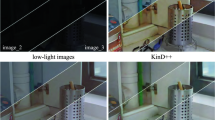Abstract
Bidirectional texture function (BTF) provides a realistic representation for real-world materials; however, the representation does not allow users to append additional rendering effects to the BTF data in a simple and effective way. In this paper, we present an approach for generating the painted appearance on a material that is represented by a BTF. We first convert a BTF into a physical representation composed of a height-field and a spatially varying bidirectional reflectance distribution function (SVBRDF). This representation allows us to simulate the appearance of paints on the surface of a material by computing the reflectance and the height field of the painted material. During rendering, we combine an existing BTF rendering approach and the modified material data to simulate the painted appearance of the BTF materials. Our experiments show that the proposed approach can simulate the painted appearance of a material while preserving the characteristic appearance of the original BTF. Our approach is mainly suitable for less specular BTF materials that allow depth reconstruction.










Similar content being viewed by others
Notes
Although a luminance-weighted average is used in [10], we found the fitting result is better when a uniformly-weighted average is used.
The local PCA method rearranges the BTF data into a BRDF-wise arrangement, and then performs clustering and principle component analysis (PCA) iteratively to compress the data. The compressed data would be a cluster map, a PCA weight map, and the eigenvectors for each cluster. These are stored as 2D or 3D textures for the rendering process. We applied this method to render the unpainted part of the object surface.
References
Baxter W, Wendt J, Lin MC (2004) Impasto: a realistic, interactive model for paint. In: NPAR ’04: Proceedings of the 3rd international symposium on Non-photorealistic animation and rendering. ACM, New York, pp 45–148
Curtis CJ, Anderson SE, Seims JE, Fleischer KW, Salesin DH (1997) Computer-generated watercolor. In: SIGGRAPH ’97: Proceedings of the 24th annual conference on computer graphics and interactive techniques. ACM Press/Addison-Wesley Publishing Co., New York, pp 421– 430
Dorsey J, Hanrahany P (2006) Modeling and rendering of metallic patinas. In: ACM SIGGRAPH 2006 courses. ACM, p 2
Duntley SQ (1942) The optical properties of diffusing materials. JOSA 32(2):61–70
Frankot RT, Chellappa R (1988) A method for enforcing integrability in shape from shading algorithms. IEEE Trans Pattern Anal Mach Intell 10(4):439–451
Filip J, Haindl M (2009) Bidirectional texture function modeling: a state of the art survey. IEEE Trans Pattern Anal Mach Intell 31:1921–1940
Huang C-G, Huang T-S, Lin W-C, Chuang J-H (2013) Physically based cosmetic rendering. Comput Anim Virt Worlds 24(3-4):275–283
Kautz J, Boulos S, Durand F (2007) Interactive editing and modeling of bidirectional texture functions. ACM Trans Graph 26(3):53
Kortüm G (1969) Reflectance spectroscopy (principles, methods, applications). Springer-Verlag, New York Inc.
McAllister DK (2002) A generalized surface appearance representation for computer graphics, Ph.D. dissertation, director-Lastra, Anselmo
Menzel N, Guthe M (2009) G-brdfs: an intuitive and editable btf representation. Comput Graph Forum 28(8):2189–2200
Müller G, Meseth J, Klein R (2003) Compression and real-time rendering of measured btfs using local pca. In: Ertl T, Girod B, Greiner G, Niemann H, Seidel H-P, Steinbach E, Westermann R (eds) Vision, modeling and visualisation 2003. Akademische Verlagsgesellschaft Aka GmbH, Berlin, pp 271–280
Philips-Invernizzi B, Dupont D, Caze C (2001) Bibliographical review for reflectance of diffusing media. Opt Eng 40(6):1082–1092
Rushmeier HE, Taubin G, Guéziec A (1997) Applying shape from lighting variation to bump map capture. In: Proceedings of the Eurographics workshop on rendering techniques ’97. Springer-Verlag, London, pp 35–44
Silberstein L (1927) The transparency of turbid media. JOSA 15(3):125–129
Tatarchuk N (2006) Dynamic parallax occlusion mapping with approximate soft shadows. In: I3D ’06: Proceedings of the 2006 symposium on interactive 3D graphics and games. ACM, New York, pp 63–69
Volz H (1962) Ein beitrag zur phänomenologischen theorie lichtstreuender und absorbierender medien, vi. fatipec kongress 1962. Verlag Chemie, Weinheim, pp 98–103
Völz H (1964) Ein beitrag zur phänomenologischen theorie lichtstreuender und absorbierender medien. In: Proceedings of the seventh FATIPEC congress, pp 194–201
Zhou K, Du P, Wang L, Matsushita Y, Shi J, Guo B, Shum H-Y (2005) Decorating surfaces with bidirectional texture functions. IEEE Trans Vis Comput Graph 11(5):519–528
Author information
Authors and Affiliations
Corresponding author
Electronic supplementary material
Below is the link to the electronic supplementary material.
Rights and permissions
About this article
Cite this article
Chen, TE., Huang, TS., Lin, WC. et al. Simulating painted appearance of BTF materials. Multimed Tools Appl 77, 7153–7169 (2018). https://doi.org/10.1007/s11042-017-4626-9
Received:
Revised:
Accepted:
Published:
Issue Date:
DOI: https://doi.org/10.1007/s11042-017-4626-9




